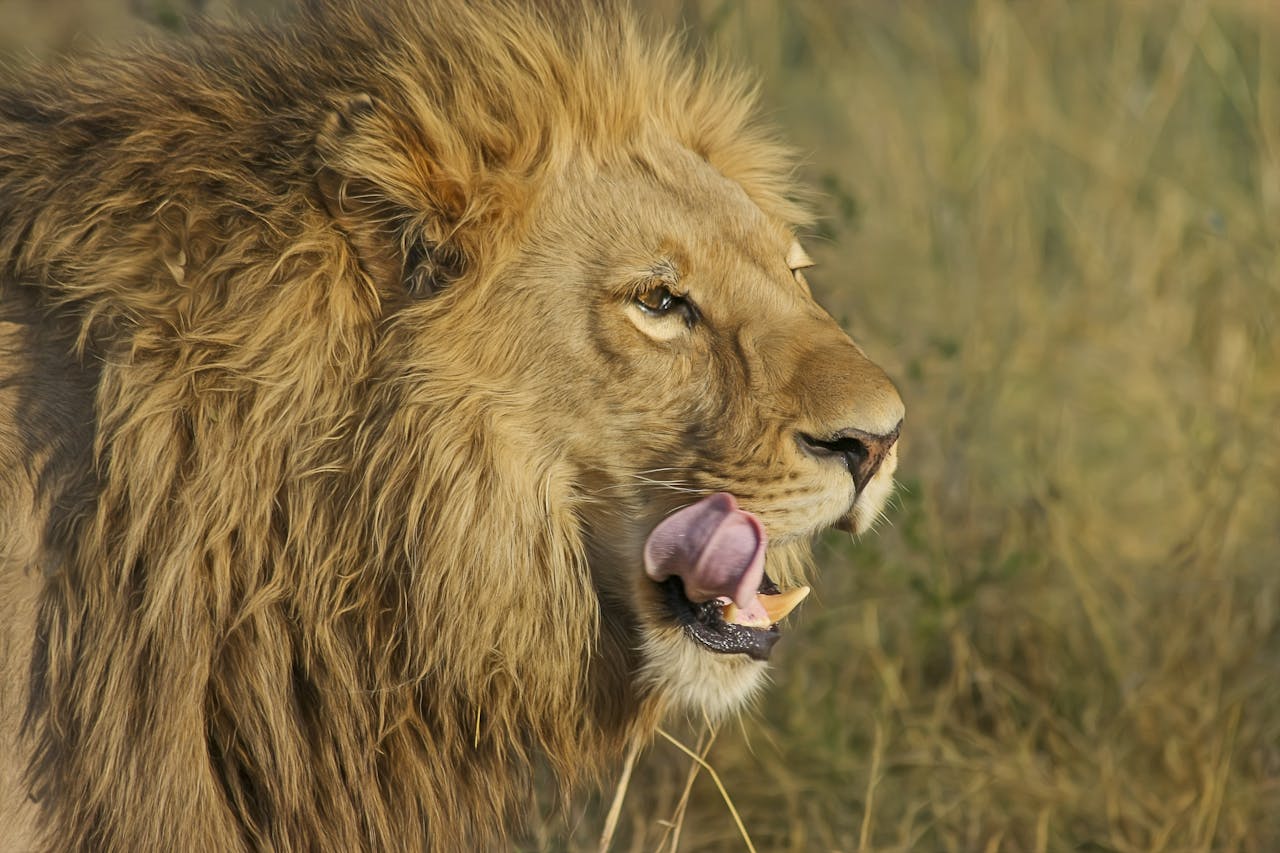Your cart is currently empty!
Rhino Poachers Eaten Alive By Lions On South African Game Reserve

In the eerie quiet of a chilly July morning in 2018, the Sibuya Game Reserve in South Africa became the grim stage for a stark and savage reminder of nature’s untamed force. Here, in one of the Eastern Cape’s most cherished wildlife sanctuaries, a dramatic and fatal confrontation unfolded—not between rival animal species, but between human intruders and the natural guardians of the reserve. This incident, involving suspected poachers and a pride of lions, highlights a cruel irony in the ongoing battle against illegal wildlife trade, particularly the poaching of rhinoceroses for their coveted horns. As the details of this tragic encounter come to light, they reveal not only the perils faced by those who seek to exploit nature but also the relentless challenges confronting those dedicated to its preservation. This article delves into the circumstances of that fateful encounter, offering a lens into the broader, global crisis of wildlife poaching and the efforts to thwart it.
The Fatal Encounter at Sibuya Game Reserve
In the early hours of a July morning in 2018, the serene landscape of Sibuya Game Reserve was the unexpected backdrop for a deadly encounter that highlighted the perilous extremes of wildlife conservation. This section details the incident where suspected rhino poachers tragically fell victim to the very animals they intended to exploit.
The confrontation took place between the evening of July 1st and the early morning of July 2nd, when a group of men illegally entered the Sibuya Game Reserve, a renowned sanctuary for wildlife in the Eastern Cape of South Africa. These men, equipped for a prolonged and illegal hunting expedition, were believed to be targeting the reserve’s rhinos, drawn by the high value of rhino horns on the black market.
The reserve’s anti-poaching dogs first alerted handlers to the intrusion, followed by audible disturbances from a nearby lion pride. The situation escalated quickly, leading to a violent encounter with the lions. By morning, reserve staff, alerted by the dogs and the subsequent commotion, discovered a gruesome scene: scattered human remains and poaching tools, including a high-powered rifle with a silencer, an axe, and wire cutters.
Nick Fox, the owner of the reserve, was swiftly informed of the incident. The reserve’s team, alongside local police, conducted a thorough search of the area. The presence of multiple pairs of shoes and gloves suggested the number of intruders, and given the evidence, it was presumed that three poachers had been killed, although the exact number could not be confirmed due to the condition of the remains.
This tragic event underscores the ongoing conflict between poaching activities and wildlife conservation efforts. Sibuya Game Reserve, like many others across Africa, has been a frequent target for poachers due to its population of endangered rhinos. Rhino horns are highly sought after in parts of Asia for their alleged medicinal properties, fetching high prices on the black market.
This incident at Sibuya is a stark reminder of the dangers and moral complexities involved in the fight against illegal wildlife trade—a fight that not only endangers the lives of animals but also those of humans entangled in its vicious cycle.
The Sibuya incident led to increased calls for more robust anti-poaching measures and highlighted the critical role of trained anti-poaching dogs and surveillance in protecting wildlife. It also sparked a broader discussion on the need for international cooperation and more effective legal frameworks to combat wildlife trafficking.
The Poaching Crisis

The tragic incident at Sibuya Game Reserve is a somber reminder of the escalating poaching crisis that continues to devastate wildlife populations across Africa, particularly rhinos. This crisis is fueled by the high demand for rhino horns in parts of Asia, where they are erroneously believed to possess medicinal properties.
Current Poaching Trends Despite concerted efforts to combat poaching, South Africa remains at the epicenter of rhino poaching. In 2022, the country saw a slight decrease in the number of rhinos poached, with 448 rhinos killed, down slightly from 451 in 2021. This decrease reflects ongoing efforts in surveillance, law enforcement, and community engagement aimed at protecting these magnificent creatures.
Impact and Conservation Efforts Kruger National Park, one of Africa’s largest game reserves, has traditionally been a major target for poachers due to its size and the biodiversity it harbors. Recent measures in the park, such as improved security systems and dehorning programs, have contributed to a decline in poaching numbers. However, poachers have adapted by shifting their focus to other regions, such as KwaZulu-Natal, which saw a significant loss of rhinos in 2022.
Across Africa, the situation remains dire, with Namibia and other countries also experiencing substantial poaching activities. The International Union for Conservation of Nature (IUCN) reported a slight overall increase in rhino populations due to conservation efforts, but the threat of poaching continues to loom large, necessitating continued vigilance and international cooperation.
Moving Forward To combat this crisis, it is crucial to maintain and enhance anti-poaching initiatives, including ranger training, community conservation programs, and international law enforcement cooperation. Public support and global awareness are also vital in reducing demand for rhino horns and supporting conservation funding.
The fight against poaching is not only about protecting wildlife but also preserving ecological balance and supporting local communities that benefit from biodiversity through tourism and sustainable practices. The tragedy at Sibuya Game Reserve serves as a powerful call to action to strengthen these efforts globally.
Innovations in Anti-Poaching Efforts in South Africa

As the battle against wildlife poaching intensifies, South Africa is employing increasingly innovative strategies to protect its rhinoceros populations. These efforts combine advanced technology, community involvement, and international cooperation, reflecting a holistic approach to conservation.
Radioactive Tracking Technology – One of the groundbreaking strategies includes the injection of radioactive chips into rhino horns. This initiative, known as the Rhisotope Project, is led by researchers at the University of the Witwatersrand. The chips are designed to trigger radiation detectors at borders, helping to alert authorities about the smuggling of poached materials. Additionally, the chips render the rhino horns poisonous, drastically reducing their market value and thus deterring poachers. This approach has been praised for its potential to halt the illegal trade in rhino horns without harming the animals themselves.
Tech-Driven Surveillance and Deterrence – In Sabi Sand Reserve, anti-poaching efforts have seen significant success through the integration of technology. Advanced surveillance systems, including drones and infrared cameras, have been employed to monitor wildlife and detect poaching activities. These technologies provide real-time data, allowing rapid response from anti-poaching units. Moreover, the reserve has adopted a comprehensive approach that includes dehorning rhinos to make them less attractive targets for poachers.
Educational and Research Collaborations – The University of Pretoria has partnered with various stakeholders to launch an anti-poaching research program aimed at developing new strategies to combat wildlife crimes more effectively. This program emphasizes the importance of scientific research and community education in fostering long-term conservation success.
Community Involvement and Global Cooperation – Efforts to combat poaching are not limited to technological and scientific approaches. Engaging local communities and improving socioeconomic conditions are also crucial. Programs that involve community members in conservation efforts help to reduce poaching by providing sustainable alternatives to illegal activities. Furthermore, international collaborations enhance the effectiveness of these efforts by ensuring that measures taken are comprehensive and supported globally.
How You Can Help Combat Poaching
While anti-poaching efforts on the ground are vital, support from individuals around the world plays a crucial role in sustaining these initiatives. There are several ways you can contribute to the fight against wildlife poaching and help protect species like rhinos from extinction.
1. Support Conservation Organizations – Donating to organizations that are directly involved in anti-poaching efforts can make a significant difference. These funds help provide the necessary equipment, training, and resources that rangers need to effectively protect wildlife. Organizations such as Save the Rhino, the International Rhino Foundation, and the African Wildlife Foundation are at the forefront of these efforts. Your contributions support field rangers, community conservation projects, and critical research.
2. Stay Informed and Raise Awareness – Educating yourself and others about the threats of poaching and the importance of conservation can lead to broader public support. Sharing articles, joining conservation groups on social media, and participating in discussions can spread the word about the urgent need for wildlife protection. Awareness campaigns help reduce demand for illegal wildlife products by informing potential consumers about the real costs of poaching.
3. Support Policy Changes – Engaging with policymakers to support wildlife protection legislation is another powerful way to contribute. By advocating for stricter laws and penalties for poaching and wildlife trafficking, you can help create a legal environment that deters criminals. Contacting your representatives to express support for wildlife conservation policies can influence decisions that have a lasting impact on global biodiversity.
4. Volunteer Your Time – Many conservation organizations offer volunteer programs that allow you to get directly involved in anti-poaching efforts, whether through field work, educational programs, or fundraising events. Volunteering gives you a hands-on opportunity to contribute to conservation efforts and see the direct impact of your involvement.
5. Promote Eco-Tourism – Choosing to support eco-tourism initiatives can also have a positive impact. Eco-tourism provides a sustainable economic alternative for communities that might otherwise turn to poaching as a source of income. By visiting wildlife reserves and parks, you contribute to the local economy and incentivize the protection of natural habitats.
A Unified Call to Action
The tragic event at Sibuya Game Reserve, where poachers were fatally attacked by lions they intended to victimize, underscores the urgent need for comprehensive anti-poaching strategies. This incident highlights the complex interplay between human desperation, economic incentives, and wildlife conservation. Effective countermeasures require robust international cooperation, innovative technology, community integration, and widespread education to tackle both the symptoms and root causes of poaching. It’s a stark reminder of the moral and ecological implications of wildlife crime and the importance of global awareness and personal responsibility in conservation efforts. Through collective action and sustainable development, we can aim for a future where wildlife and humans coexist more harmoniously.
